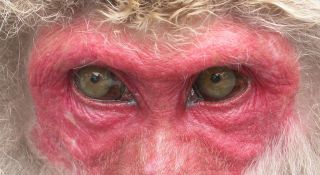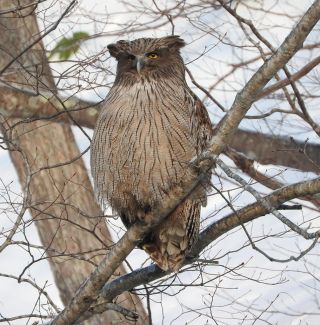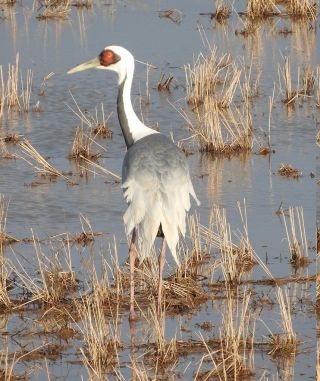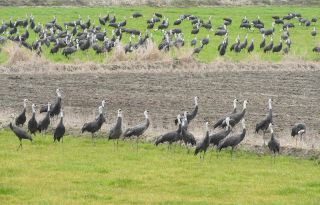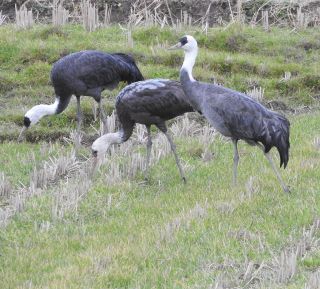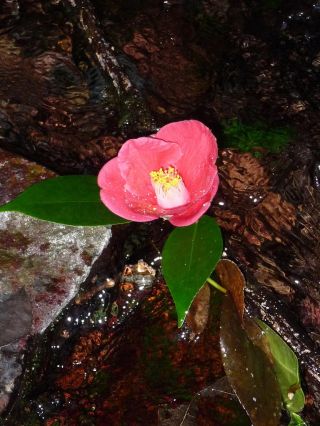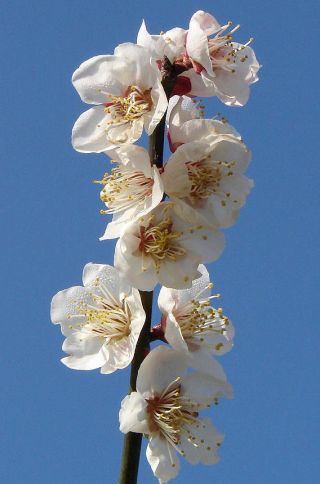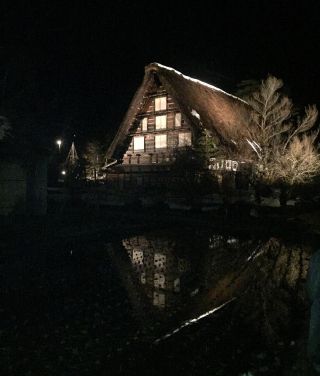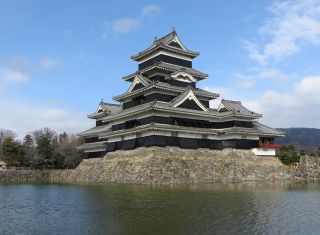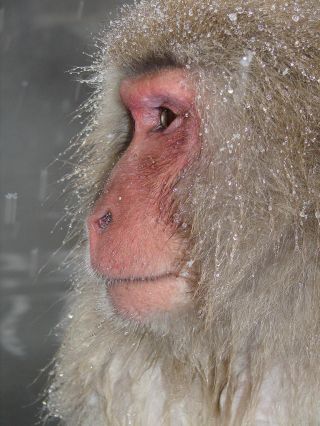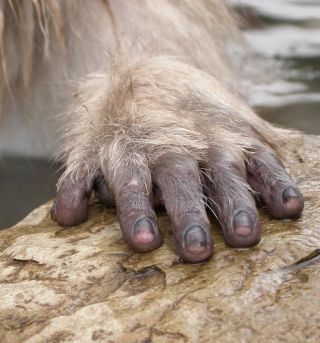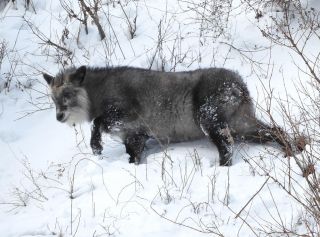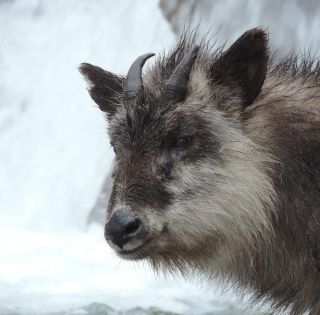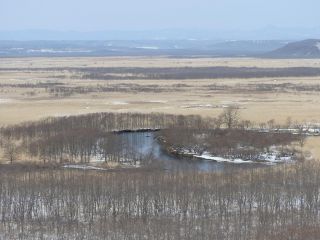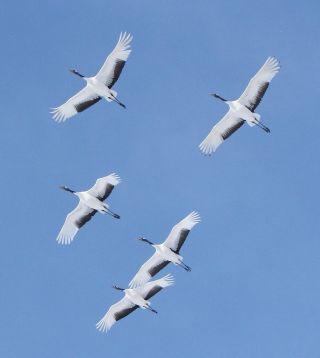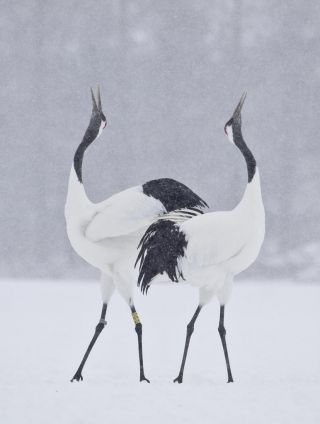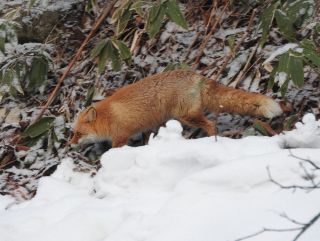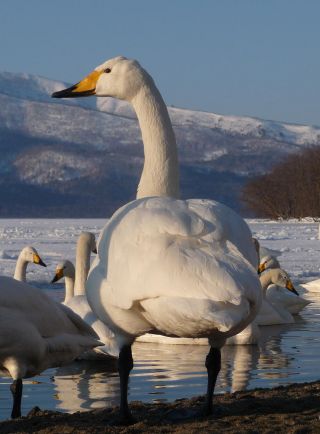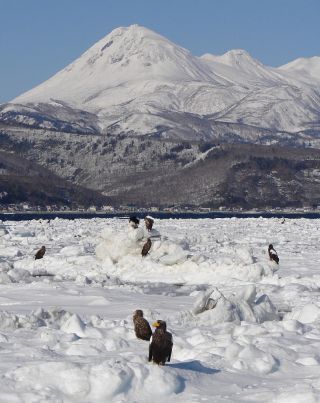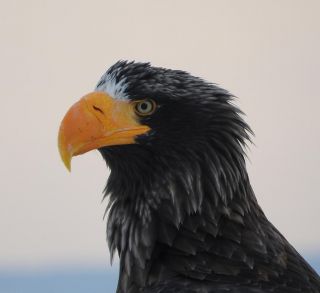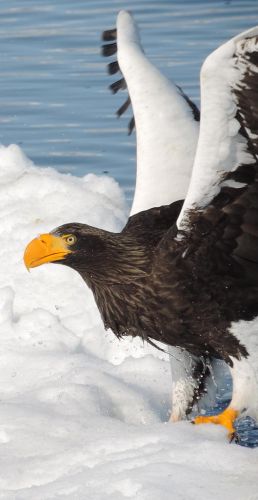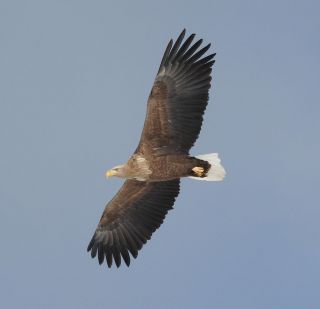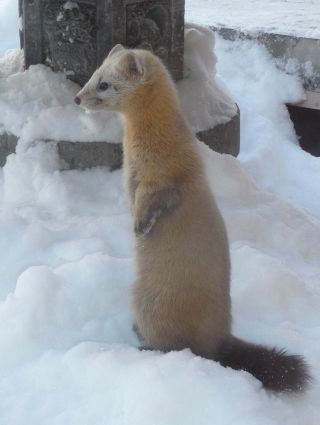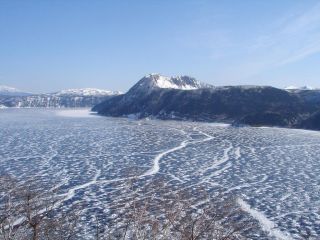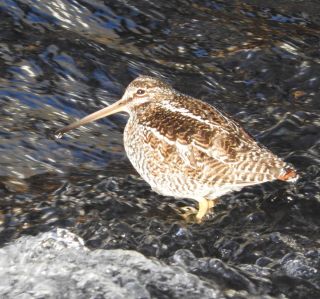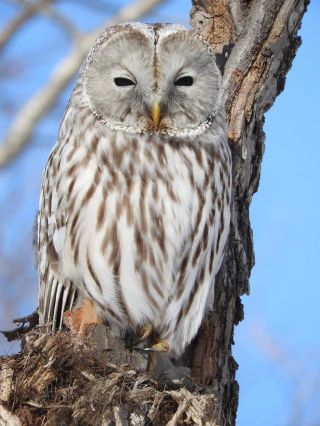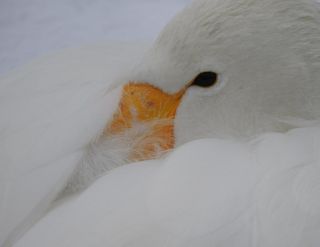Windows into the soul of the Japanese Macaque © Mark Brazil
Snow Monkeys & Cranes of Japan: Spectacular Winter Wildlife
By Mark Brazil | Feb 29, 2016
A deep, sonorous hoot reverberates through the frigid night air, echoing through riverine forest. A pair of Blakiston’s Fish Owl has been calling in their traditional territory for over an hour. They began unusually early, while it was still daylight, when their cryptic plumage almost hid them against the bark of forest elms. Their enormous rounded shapes out of context in the criss-cross of branches was their give away – that and their wonderful calls.
Owl calls seem to echo from the depths of time, their primal notes bonding male to female, helping mates synchronize their lives, their years, their days. In the case of these fish owls each double note given by the male and each single response by the female is presaged by a pale, bulbous swelling of their white throat feathers. This is a visual signal that suggests a summoning of power, and voice and history.
Tonight, they have called repeatedly and for so long that I sense something exciting is imminent. Soon after dusk has gathered into darkness the female, quickly followed by the male, flies up to a distant tree top and there, in hurried consummation, they cement their bond. Perhaps this year they will breed successfully.
The antiphonal duet of the fish owls has long been the nocturnal backdrop to these riverine sites where once animistic Ainu people made their homes. Not for nothing do they dub this creature Kotan Koru Kamuy (the God of the Village). For them this is the ultimate deity, greater even than Kimun Kamuy, the bear god of the mountains.
For me the fish owl and its powerful duet is the lynchpin of one of my annual journeys through Japan, each encounter with this deity brings a sense of nostalgia, as I think back on the history of the people of Hokkaido, and on some of my earliest experiences here. I cannot help thinking of the intertwined fates of both Ainu and fish owl as their lands have been overwhelmed and as they face different forms of extinction, one cultural the other biological.
Where the lynchpin of my journey is the fish owl, the building blocks are the cranes and the landscapes of Kyushu and Hokkaido in which they live. Each winter many thousands of these elegant, long-lived birds migrate into Japan’s southern main island of Kyushu by way of the Korean peninsula from their breeding grounds in Mongolia, northeast China and eastern Russia. In squadrons the diminutive sooty grey Hooded Crane wings its way southwards during October, gathering at the now world famous crane site at Arasaki, in Kagoshima Prefecture. With them come lesser numbers of their more elegant but more endangered cousins, the White-naped Crane. Together their numbers have reached an impressive 17,000, a great increase since the 4,000 or so that I saw here on my very first visit. Amongst that wintering horde are hidden a handful of Common and Sandhill cranes, exciting needles in an avian haystack for visiting birdwatchers and photographers to seek out. Sometimes the magnetic lure of this enormous flock attracts cranes even more rare than these; on occasions I have seen Siberian and even Demoiselle cranes here, and just once a lost Red-crowned Crane.
During late February and early March warming southerly winds are the trigger for the cranes to commence their return migration, though they are still several months away from breeding, yet already the locally resident Grey Herons are already incubating their eggs in their nearby coastal colony. Each winter the reclaimed coastal lands around Arasaki host other migrants in addition to the cranes, endangered Black-faced Spoonbills at the pools, and rare Daurian Jackdaws (amongst hosts of wintering Rooks) around the farmland.
The elegant bowing displays are perhaps what endears the cranes to the Japanese people, but what endears off-the-beaten-track Japan to many overseas visitors is the deep and sophisticated culture of the Japanese people themselves, from their UNESCO recognised cuisine to their immersive hot springs, from their traditional modes of dress and address to their extraordinary attention to detail.
In Japan, there is always a recognised way of doing things, of doing every thing, a way that has evolved over generations and that has been reassuringly retained as a conservative ritual. I call it “The Way”. Follow the way, and all will be well, whether it is following the numbered way to unwrap a store bought onigiri (rice ball), dressing in yukata, so as to appear alive (left over right) not dead (right over left), shedding shoes and physical and spiritual dirt in the genkan without sullying one’s socks on the genkan floor or the inner floor with one’s shoes, or not interrupting the flow of a kaiseki meal. Mess with the way and all manner of chaos may follow. The way is redolent with ritual, and like ritual elsewhere delving into it for meaning or origin is itself meaningless. It merely is. For those willing to accept it the ritual of the way provides a reassuring still point in a hurried and uncertain life. For those unable to accept rules, rituals and conservative ways, then Japan can be a daunting challenge.
Coming from the intensely “Me” cultures of the west, visitors to Japan can also be daunted because of their exposure to the all encompassing “Us” culture of the east. The ramifications of each culture in our respective thought processes are the stuff of books, not a paragraph in a nature article. Suffice it to say that one cannot pass even a few hours in Japan without some kind of incidental cultural experience. For those with open minds and a desire to explore these aspects are so vastly different as to be fascinating.
From the seemingly simplistic traditional architecture of the samurai quarter of Izumi and the once-hidden farming village of Shirakawa-go that has become a World Heritage Site, to the inspiringly powerful symbolism of the black crow castle at Matsumoto, from artistically designed Japanese gardens in Kyushu to carefully crafted woodwork and lacquerware in Takayama, and woodblock prints and Ainu-style wood carving and embroidery in Hokkaido, there is so much incidental artistry in my annual excursion through Japan that I could easily be side-tracked into a cultural journey, but my focus remains on Japan’s extraordinary bird and mammal faunas. [The photographs accompying this article have been selected from several of my past trips.]
The mountain valleys and forested slopes of central Honshu are home to two remarkably different endemic creatures. One is the social, even boisterous, Japanese Macaque, high on the list of things Japanese that visitors long to see. It is often dubbed the “Snow Monkey” for its capacity to survive even in harsh snow-covered winter landscapes, but it would be better named the “Onsen Monkey” for that is where most visitors wish to see it – lolling in warm water after a meal as if on a weekend break. The other is the solitary and shy Japanese Serow, which is not only mostly overlooked by casual visitors, but rarely even features on their radar screens. When passers-by notice me watching one through my telescope the commonest question is not, “what is that?” but instead “is that a bear or a wolf?” Hours spent waiting for the perfect monkey shot in the famous Jigokudani (literally hell valley) of Nagano Prefecture, are often as not rewarded with a glimpse of a ghostly grey shape as a serow pushes its way through the snow on the hillside above. It is a welcome reward as birds here are few and far between, though occasionally a Golden Eagle, Mountain Hawk Eagle or an Alpine Accentor puts in an appearance.
Hokkaido offers a counter balance to the great flock of cranes in Kyushu, not in numbers, but in sheer beauty. Each winter I ponder the relative merits of the elegant shades of grey and white that mark the White-naped Cranes of Kyushu out from the merely pied plumage of the Red-crowned Cranes of Hokkaido. Yet when I consider the delightful contrast between the deep red cap and the boldly patterned feathering of the northern crane and factor in their stature, their seemingly joyful vivacious dances and their evocative vocalisations, then I realise that it is, as my North American friends call it, “a no-brainer”; the Red-crowned Crane truly stands out from the crowd as the most beautiful of all the cranes.
Following the Red-crowned Cranes from their riverine roost sites to their foraging grounds and back, learning about their daily cycle of behaviour and how it relates to the weather – especially the temperature – is one of the joys of winter days in east Hokkaido. One of the challenges is looking out for wandering Red Foxes all the while along the way. They are surprisingly diurnal in winter in Hokkaido and my record stands at 33 fox sightings in a week. These seemingly conspicuous long-furred creatures with their bushy, white-tipped tails are renowned shape-shifters in Japanese folklore, and given their ability to appear and disappear in a white landscape that mythical role is not surprising. They are on the hunt for voles that live through winter mostly beneath the white expanse of snow that covers the agricultural land, though occasionally they put in an appearance for us above ground skittering across the surface of the snow. When a fox hears a vole beneath the snow it suddenly seems spring-loaded, leaping up into the air only to pounce down with all four feet together, punching down through the snow crust to trap the vole beneath. In this way I have watched them pull vole after vole from a hidden nest. Foxes also patrol the shorelines of lakes and seas and there they encounter swans and eagles, neither will give way to a fox.
Whooper Swans are the angels of winter. They gather against inspiring scenery at a number of riverine and lakeshore sites in east Hokkaido. There, their soft, night-time contact whoops rise into clamouring and trumpeting calls during the daytime as birds come and go from the wintering flocks. White is such a poor description of their plumage as they fly against backgrounds that range from the deep azure of a clear winter’s day to the leaden grey of a snow-laden sky. Their whiteness ranges from brilliant to buttery depending on their backdrop. Sleeping, with their necks insinuated backwards into the frosted plumage of their mantles, and huddled against winter snowstorms, the deep egg-yolk yellow and coal black of their bills, and their dark eyes are all that relieve the whiteness of the blizzard. When they take-off en masse into the wind, clamouring into flight with their quills rattling and buzzing, it is they that are the blizzard.
A small number of swans have taken to gathering at river mouths on the Shiretoko Peninsula, the rugged north-eastern finger of Hokkaido, but they are overlooked by most visitors there who are intent on other migrants from Russia. Sometimes these include Steller’s Sea Lion, but the main draw is Steller’s Eagle. These enormous, eponymous birds gather along the Pacific coast of the peninsula where it looks out across the Nemuro Channel towards the island of Kunashir.
Though the eagles were once numbered in their thousands here in winter, a catastrophic decline in the local fishing industry based in Rausu, and hence in the volume of waste fish that once fell from the fishing nets, has led many of them to disperse more widely across Hokkaido making encounters possible on almost any day in the east. Nevertheless, the remaining hundreds on the Shiretoko Peninsula are still wonderfully impressive, especially when seen from offshore as they swoop past on enormous wings, or rest on the floating drift ice, that in some winters still graces the Nemuro Channel.
There is no more dramatic bird of prey in the world than Steller’s Eagle. Whereas one might by lucky to see two or three during a summer journey to their Kamchatkan range, in winter a dozen or more my cluster like overgrown fruit in a single tree on the coastal escarpment. Dark, almost blackish chocolate brown, with broad white shoulders, white thighs and an enormous white tail, Steller’s Eagle is a gentle giant compared with its smaller, but more aggressive cousin, the White-tailed Eagle.
Towards late winter pairs of eagles begin to display, chasing each other in flight, performing paired aerobatics and barking hoarsely at one another. At such times the larger, seemingly lumbering Steller’s Eagle puts its smaller eagle relative to shame, as it reveals an astonishing agility in the air and a surprising turn of speed as it dashes, almost falcon-like in pursuit of a mate. Once they commence displays such as this their thoughts will begin to turn to the breeding season ahead and they will commence moving north, back to Kamchatka or the northern shores of the Sea of Okhotsk. As they head northwards on giant wings they will draw closed behind them the curtains of winter. There may still be snow all around, and frequent blizzards in this white landscape, but spring, and the greenery it brings, is not far away now.
Hokkaido’s suite of mammals is at first sight an odd one, there are conspicuous gaps, species are missing that are common in Honshu and further south, while others are noticeably present in the north, but nowhere to be found in Honshu. It all hinges on understanding the significance of the Tsugaru Channel, a deep-water channel that has long separated Hokkaido from the rest of Japan. We now recognise that running through it there is a biogeographical line, known as Blakiston’s Line, which delineates the disparity between the northern, Russian-influenced fauna and flora of Hokkaido and the southern, continental Asian-influenced fauna and flora of the three other main islands of Japan. The Japanese Macaque and Japanese Serow are notably absent from the north, but then the predatory, nocturnal Sable is an exciting replacement. The Eurasian Red Squirrel is a northern bonus, and some species do admittedly cross the line, such as the Japanese Deer, but the subspecies in the north is remarkably larger than those in the south. Marine mammals are far more evident off the east Hokkaido coast in winter, with Largha Seal and Steller’s Sea Lion quite possible, but almost unheard of further south.
Hokkaido also provides other distractions, not to mention stunning scenery such as at lakes Mashu and Kusharo. Some of those distractions, such as the truly Solitary Snipe, are for the birding connoisseurs, others such as the pale northern race of the Ural Owl appeal to one and all. The snipe, as its name suggests, keeps to itself as it forages along ice-free sections of river, sharing its habitat, but not its habits, with the Brown Dipper and the Crested Kingfisher. The dipper is an early breeder, frequently in song from a riverside rock while nearby the snipe probes between stones on the river bottom. Overhead the punk-crested kingfisher streaks in a flash of grey and white; the snipe merely pauses and crouches, as it does when a wandering White-tailed Eagle drifts overhead.
Travelling through Japan in winter allows one to witness and photograph some of the most spectacular winter gatherings of wildlife in Asia and each winter there are surprises – perhaps an errant rare crane, a sighting of a Large-clawed Shrew in the open, a West Japanese Toad in Kyushu, or as was the case this year a cherry tree in full bloom in February when plum blossom is the norm.
The greatest highlight of my most recent foray was a brief, but definitive, sighting of Hokkaido’s critically endangered freshwater salmonid, the enormous Japanese Huchen (Hucho perryi), which may exceed two metres in length. It broke from the water of Lake Shirarutoro almost like a leaping River Otter and almost the same size, startling those of us who glimpsed it. It appeared to be a little over a metre in length and while it may not have been a record-breaker in size it was certainly a record maker for me. It is impossible to guess what unexpected sightings my next journey will bring, but I have little doubt that there will be something new.
This story really begins back in 1982, for that was the year in which I led my very first naturalist visitors to Japan in search of birds. It was a modest beginning. I led Dr and Mrs Smith, visitors to Tokyo, on day trips to the Mt Fuji and Zushi areas in July of that year in search of summer songsters; then, in October I led Dr Jim Clements (later famous for The Clements Checklist of Birds of the World) and friends for four days around east Hokkaido in search of birds and mammals.
From that small beginning I went on to lead naturalists, birdwatchers, birders, world bird listers, radio and television crews, researchers, conservationists and wildlife photographers on journeys that have taken me the length and breadth of Japan. I have travelled with guests from Wakkanai in northern Hokkaido to Iriomote in the southern Ryukyu Islands, from Mt Fuji to the Izu and Ogasawara Islands, so many times that I have lost count of the number of trips and the number of clients. One day, perhaps, I will have the time to mine my shelves of notebooks and find out how reliable is my guestimate of 100s of trips and 1000s of guests.
The second beginning of this story was twenty years later, in 2002, on board the Clipper Adventurer, an expedition cruise ship, plying the jungle rivers of northeast South America. I was there at the invitation of Zegrahm Expeditions on my first ship-based expedition cruise, and two of that company’s founders, Peter Harrison and Shirley Metz, were on board. During our exciting tropical voyage the conversation turned repeatedly to Japan and its remarkable winter environment and before long I was being asked whether I would design, and lead, an expedition focussing on photographing the wonderful winter wildlife of my adopted home. How could I refuse, especially when given free rein to decide all of the key elements of the trip from the locations to the accommodation?
I remember vividly being told, make it fun, so much fun that you’ll want to lead it again and again. Those were not idle words and I took them seriously, and at that stage I was clear that fine Japanese dining, hot springs, and accommodations with character had to accompany the wildlife and photographic highlights; and so was born an exploration of off-the-beaten-track Japan at a season that most visitors shunned. So unusual was the concept of the tour at that time that it was a struggle to even have our bookings accepted at some of the accommodations more than three months ahead of the trip. So much has changed over the intervening years, not least being the enormous surge in visitors to Japan.
Snow Monkeys & Cranes of Japan was launched in 2003 with the first tour planned for 2004. If that first tour proved successful we envisaged running the trip every second year or so depending on interest. Little did we know then how astonishingly popular Japan in winter was to prove to be.
Now Japan is far more widely known as an international destination for wildlife enthusiasts and it is justifiably described as providing the best winter wildlife photography in the world. I have just returned from leading our 19th Snow Monkeys & Cranes of Japan expedition, but I am already eagerly looking forwarding to celebrating the trip’s coming of age on its 20th iteration in 2017.
Outro
If you have read this far, then you may enjoy my previous articles, including recent offerings such as: “Amami Night Safari” (January 2016) “Life at the Water’s Edge” (December 2015), “The Bird that Saved Me from Death” (November 2015), “Crowing about Ireland” (October 2015), “Silk-winged Emperors” (September 2015). These and many more can be found on this website, and on our Facebook page (please do visit and hit the “Like” button).
Author and naturalist Dr Mark Brazil has written his Wild Watch column continuously since April 1982. All Wild Watch articles dating back to 1999 are archived here for your reading pleasure. A collection of Mark’s essays The Nature of Japan and two handy pocket guides The Common and Iconic Birds of Japan and The Common and Iconic Mammals of Japan have been published and are also available from www.japannatureguides.com

